Best Practices for Structural Maintenance and Repairs
Maintenance and restorations of structures are essential for ensuring the safety, dependability, and durability of buildings and other structures. Best practices for structural maintenance and restorations include the following:
- Regular inspections: A qualified structural engineer should conduct routine inspections to detect any signs of wear and strain or damage. This includes inspecting structural elements for fractures, corrosion, and deformation.
- Timely repairs:Any problems that are identified should be remedied immediately. Delaying restorations can result in more extensive damage and compromise the integrity of the structure.
- Proper materials:To prevent compatibility issues, the materials used for restorations should be compatible with the existing materials. The use of inappropriate materials can result in additional damage.
- Qualified professionals:All maintenance and repair work should be performed by qualified and experienced professionals who have a thorough understanding of the fundamentals of structural engineering.
- Preventive measures: Preventive measures, such as applying protective coatings or installing drainage systems to prevent water damage, should be included in structural maintenance.
- Regular cleansing: Regular cleaning of structures can aid in preventing corrosion, particularly for structures that are exposed to environmental conditions such as salt spray, acid rain, and high humidity.
- Keeping records: All maintenance and restoration work performed on a structure should be documented. This will ensure that the maintenance work is performed efficiently and in a timely manner and can be referred to in the future.
By adhering to these best practices, proprietors and operators of structures can ensure their safety, dependability, and durability.
Disclaimer: This content is provided solely for your review. Erusu Consultants takes no liability for this article. The reader is advised to form their own opinion. Please consult a structural engineer before making any final decisions.






